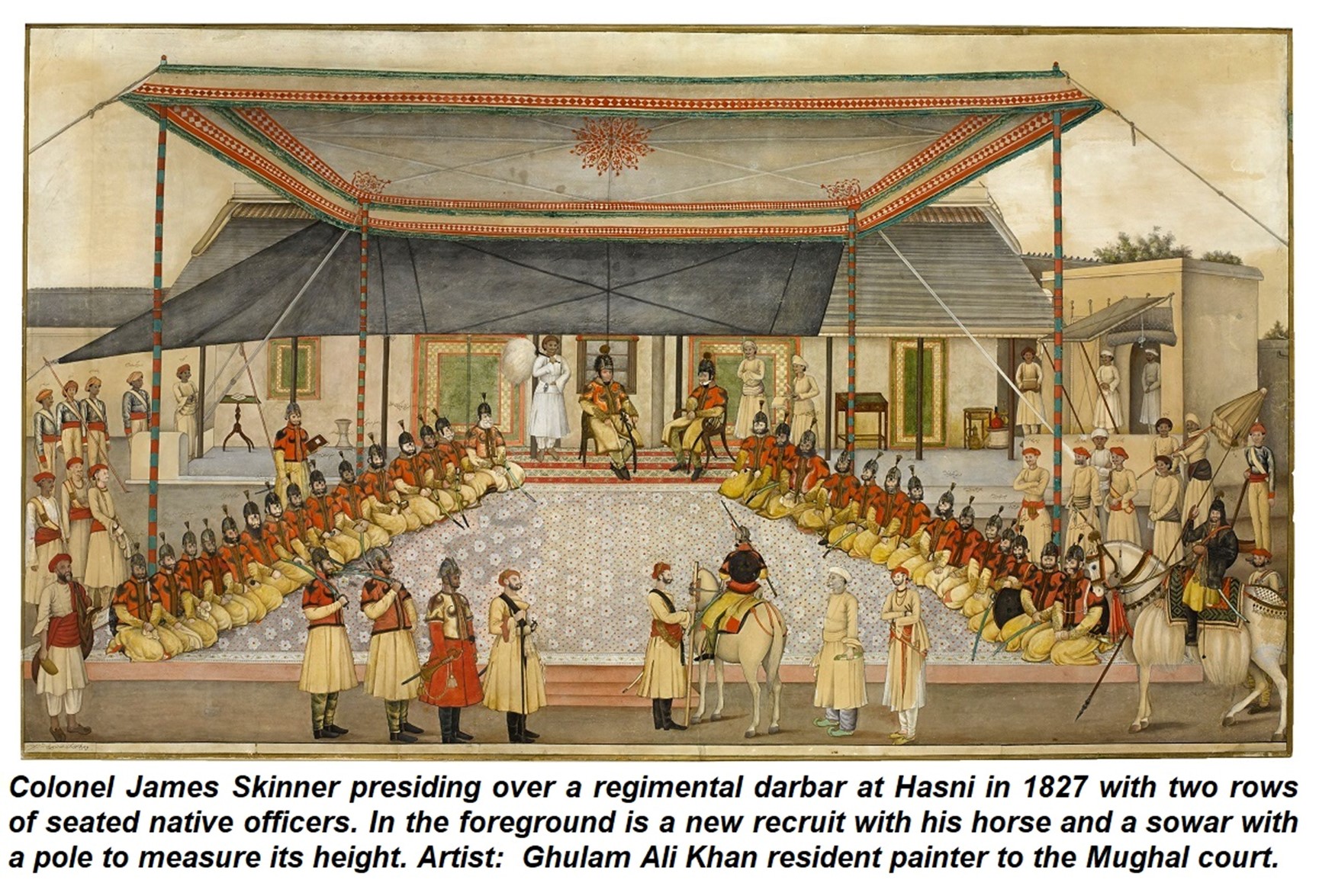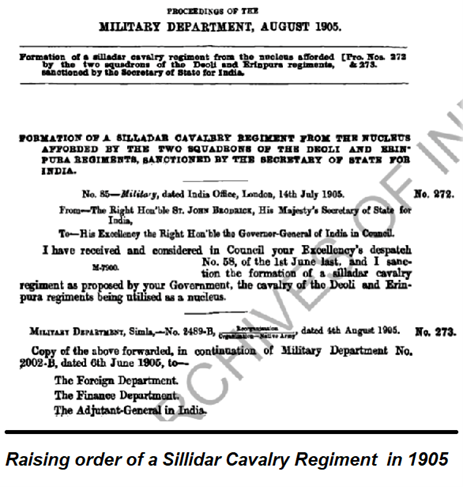In an auction in 1980, the British National Army Museum paid a high price for a collection of paintings commissioned by Col James Skinner. Two of them are magnificent panoramas. One shows the entire Skinner’s Horse returning from a review, the other the colonel presiding over a regimental durbar at Hasni in 1827. On its lower left is inscribed, ‘The work of Ghulam Ali Khan painter resident of the Caliphate of Shahjahanabad completed in the Christian year 1827’. He was one of the last miniature painters of the Mughal Court.

The Irregular cavalry regiments were an interesting feature of the British India Army, and a column on the Silladar scheme, the structure on which the irregular cavalry was based, appeared in an 1898 edition of The New York Times. Central to the structure was the Sowar [rider] providing his own horse, accoutrements, forage, clothing, etc. This system was not new to India or England, which had its own Yeomen; however, in India the British perfected it to the point that it served them for over a century, through numerous frontier campaigns and colonial wars.
Cavalry had been the dominant arm in the subcontinent for centuries. The Mughals fought mostly on horseback, with only musketeers and bowmen as foot soldiers. Haider Ali fielded an army of 60,000 of which 40,000 were cavalry and Sivaji had 80,000 cavalry supported by 50,000 foot soldiers. The East India Company, on the other hand, took its time creating its mounted weapon, borrowing cavalry from the Nawabs of Arcot and Oudh in the 1700s. These regiments were ineffective and some mutinied. While a few irregular units were raised, the Madras and Bengal Presidencies primarily depended on the regular light cavalry regiments, which numbered fourteen by 1800.

The year 1801 marked a turning point in the East India Company’s cavalry. General Lake was appointed C-in-C of the Bengal Army and he welded the cavalry into an effective arm. Following the Marathas’ crushing defeat at Aligarh in 1803, the Companies army absorbed a large body of their Rohilla cavalry by raising three irregular corps, two of which survive in the Indian Army as the 1st Skinner’s Horse and 2nd Lancers (Gardener’s Horse).
Lt Col Carmichael Smith, who commanded an irregular regiment prior to 1857, credits Col James Skinner as the father of the Bengal Presidency’s Irregular Cavalry. While fielding a corps of three regiments, each with 30 Native officers, 90 Daffadars and a 1000 sowars, Skinner probably developed the pattern on which the irregular cavalry would be organized and governed. The Silladar system did not extend to the other arms and the only Silladar infantry battalions known as Jacob’s Rifles were raised by Major John Jacob.
Since the Silladar system was institutionalized by the Mughals, its terminology and words of command were in Persian and they were adopted with modifications. The Persian Aslahbardar (i.e. a soldier bearing arms) became a Silladar and Bag-girs (i.e. or holders of reigns) was corrupted into Bargirs. There were two classes: Silladar or gentlemen, who provided a horse at their own expense, and the Bargirs who were supplied with a horse by the state.

The men in short blue jackets and red turbans at the top left in the painting are the Gonzalez (probably a corruption of the Persian Gola Andaz) who worked the galloper guns or the swivel zambooraks shot from a camel. Nearly all the ranks and appointments were also in Persian e.g. Risaldar (Native Officer), Nisanchis (Standard Bearers), Nagarchis (Kettle Drummers), Vakils (Clerks), etc. There was an intermediary rank of Ressidar between Risaldar and Naib Risaldar but it was discarded. The rank of Risaldar Major (the equivalent of the Subedar Major in the infantry) was authorized nearly 80 years after the first irregular regiments were formed.
In the Durbar painting, Colonel James Skinner sits at the apex of two rows of Native officers. The regiment wore distinctive yellow kurtas (long coats) that prompted the nickname ‘the yellow boys’. Skinner was from a Scottish father and a Rajput mother, and it’s possible that he chose this colour because it represents purity to Hindus. As against 24 British officers in the regular cavalry regiments, the Silladar regiments usually had only four – the commandant, a second-in-command, adjutant and surgeon. This not only resulted in significant cost savings for British officers, but it also gave native officers greater authority and command of squadrons. Some were very old. During the Second Anglo-Sikh War, Subedar Major Mir Sher Ali, 8th Light Cavalry, was 78 years old when he was killed on the banks of the Chenab River at Ramnagar.
In 1861, the Bengal Army was re-organized and the strength of the irregular cavalry regiments were slashed by half to 13 Native officers, 54 Daffadars and 420 Sowars. Because of financial pressures, useless horses and outdated equipment continued in service. For this and other reasons, in 1872, the system was refined. The regiment provided a Sowar with a horse plus his arms and accoutrements for a fee (his assami). Often a troop commander held the assamis of all his men. Most of them were from his village and therefore his word was law. In fact, crime was rare and discipline was based on the principal of shared Izzat (respect / honour).

In the 2nd Lancers (Gardner’s Horse), the assami was between Rs350 and 400. Poorer regiments charged more but allowed a deposit of Rs 150 and the balance made up with a deduction of Rs. 3. There were other funds that the sowar had to contribute to which resulted in them being very hard up in the early years of their service. On discharge, the assami was returned giving a substantial lump sum to start retirement. The commanding officer was under a lot of pressure. He was not only in charge of a combat regiment, but also of a lending company with nearly every shareholder owing money. In some cases, he also ran a horse trading business, the regimental stud farm, which bred and sold horses.
The Durbar, which was similar to a shareholder meeting, could be held twice a week. Each of the 8 troops bought grain for the horses from the unit’s Bannias (traders), who delivered their accounts of payments and dues at the darbar. Regiments were always in debt to the bunnias, and some began buying grain from the government. Everyone had the right to speak about issues like discipline, training, administration, leave, firearms, etc., reinforcing the sense of belonging to a family. The commandant made all decisions with the advice of his British and Native officers. As depicted in the drawing, The Darbar was also used to assess recruits and in the painting a recruit probably flanked by his sponsors, is formally introduced to the commandant and his officers. Next to him stands a sowar with a pole to measure the height of the horse.

The painting is exceptional because the names and ranks or roles of nearly all the figures are inscribed in gold but the text is faded and difficult to decipher. Skinner’s Horse recruited mainly from around the Delhi region – Rohtak, Hissar, etc. therefore the men were mainly Muslims, many of whom were Ranghars; although interestingly James Skinner rarely appointed Ranghars to command appointments. As a result, many of the Native officers in the painting have names that begin with Ameer, Mirza, Sheikh, Syed, and end with Khan, indicating that they are of Central Asian (Mughal) descent. The only Hindu in the painting is Daffadar Ganga Sankar seated last on the right.
The regiments were not always well-mounted. The wealthier regiments, such as Skinner’s and Probyn’s Horse, had vast estates with stud farms, while others purchased horses from agents and depots. When the First World War broke out, the 6th KEO Cavalry (a forerunner of the 18th KEO Cavalry) was inspected at Sialkot. The GOC 2nd (Rawalpindi) Division graded the regiment below standard primarily because their horses were of very poor class and the remounts were the worst horses. So it is not surprising that the Indian cavalry regiments were not as well mounted or equipped as the British cavalry regiments of the British Expeditionary Force.

Right till the First World War, Silladar Regiments had to purchase regulation weapons from government stocks. In 1896, the 3rd Bombay Light Cavalry spent Rs. 5,363. for a Maxim machine gun from Nordenfelt Gun Company, London. Obviously, the system could not stand the test of a World War. It was only capable of absorbing the pressures of short campaigns close to home and relatively fewer casualties in men and mounts. After the war, the Indian Army was reorganised and the irregular regiments were relegated to history. However, the custom of the Durbar was adopted by the entire British Army in India and continues in its successor armies.
Bibliography
Books: The Indian Cavalry by Maj Gen Gurcharan Singh Sandhu, 1987. Izzat – Historical Records and Iconography of the Indian Cavalry Regiments by Ashok Nath, 2009. So they Rode and Fought by Maj Gen Syed Shahid Hamid. A Rough Sketch of the Rise and Progress of the Irregular Horse of the Bengal Army by Lt Col Carmichael Smith, circa 1847. A History of the British Cavalry 1816-1919: Volume 2: 1851-1871 by Lord Anglesey, 1997.
Articles: Origin of Cavalry in the Indian Army and the Silladar System by Sumit Walia. The Silladar Cavalry by Sushil Talwar. The Silladar Cavalry published in the Great War Forum by Steve Broomfield. 1st Bengal Lancers, Skinner’s Horse – Webpage of the British Empire.